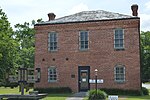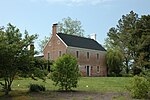Camden County, North Carolina
1777 establishments in North CarolinaCamden County, North CarolinaElizabeth City, North Carolina micropolitan areaNorth Carolina countiesPopulated places established in 1777 ... and 1 more
Use mdy dates from November 2021

Camden County is a consolidated city-county located in the U.S. state of North Carolina. As of the 2020 census, the population was 10,335, making it the fourth-least populous county in North Carolina. Its county seat is Camden. Camden County is part of the Elizabeth City, NC Micropolitan Statistical Area, which is also included in the Virginia Beach-Chesapeake, VA-NC Combined Statistical Area.
Excerpt from the Wikipedia article Camden County, North Carolina (License: CC BY-SA 3.0, Authors, Images).Camden County, North Carolina
US 158,
Geographical coordinates (GPS) Address Phone number Nearby Places Show on map
Geographical coordinates (GPS)
| Latitude | Longitude |
|---|---|
| N 36.342344 ° | E -76.162488 ° |
Address
State Employees Credit Union
US 158 101
27921
North Carolina, United States
Open on Google Maps






